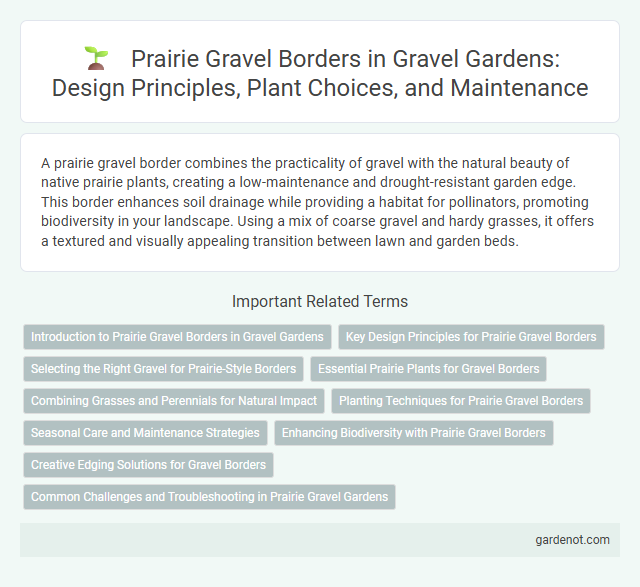A prairie gravel border combines the practicality of gravel with the natural beauty of native prairie plants, creating a low-maintenance and drought-resistant garden edge. This border enhances soil drainage while providing a habitat for pollinators, promoting biodiversity in your landscape. Using a mix of coarse gravel and hardy grasses, it offers a textured and visually appealing transition between lawn and garden beds.
Introduction to Prairie Gravel Borders in Gravel Gardens
Prairie gravel borders in gravel gardens combine native prairie plants with well-draining gravel substrates to create sustainable, low-maintenance landscapes that support biodiversity. These borders utilize drought-tolerant grasses and wildflowers such as little bluestem, purple coneflower, and black-eyed Susan to thrive in gravelly soils while attracting pollinators. Incorporating prairie gravel borders enhances soil stability, reduces erosion, and promotes a natural aesthetic that mimics prairie ecosystems.
Key Design Principles for Prairie Gravel Borders
Prairie gravel borders combine drought-tolerant native grasses with crushed stone to enhance soil drainage and reduce maintenance. Emphasizing native prairie plants like little bluestem and purple coneflower ensures ecological harmony while gravel provides a naturalistic texture contrast. Strategic layering and soil preparation are essential to support root systems and sustain plant health in gravel-based prairie gardens.
Selecting the Right Gravel for Prairie-Style Borders
Selecting the right gravel for prairie-style borders involves choosing materials that complement native prairie plants and enhance drainage. Opt for angular crushed stone with muted earth tones to create a naturalistic look that mimics prairie soil texture. Gravel size between 1/4 to 3/8 inch balances aesthetics and functionality, promoting healthy root growth while preventing weed spread.
Essential Prairie Plants for Gravel Borders
Essential prairie plants for gravel garden borders include native species like little bluestem (Schizachyrium scoparium), purple coneflower (Echinacea purpurea), and prairie dropseed (Sporobolus heterolepis). These drought-tolerant plants thrive in well-drained, rocky soil and attract pollinators such as bees and butterflies. Incorporating switchgrass (Panicum virgatum) and black-eyed Susan (Rudbeckia hirta) enhances visual interest and supports local biodiversity in gravel garden landscapes.
Combining Grasses and Perennials for Natural Impact
Prairie gravel borders create a natural impact by combining native grasses such as Little Bluestem and Switchgrass with perennials like Coneflowers and Black-eyed Susans. This blend enhances biodiversity while maintaining a low-maintenance landscape that thrives in well-drained, gravelly soil. The textured contrast between grasses and flowering perennials promotes visual interest and supports local pollinators throughout the growing season.
Planting Techniques for Prairie Gravel Borders
Planting techniques for prairie gravel borders emphasize selecting native drought-tolerant species such as coneflowers, bluestem grass, and black-eyed Susans to thrive in well-drained, nutrient-poor substrates. Incorporating deep-rooted perennials enhances soil stabilization and supports natural water retention within the gravel matrix. Strategic spacing ensures optimal air circulation and mimics natural prairie biodiversity, reducing weed growth and maintenance needs.
Seasonal Care and Maintenance Strategies
Prairie gravel borders thrive with seasonal care that includes regular weeding to prevent invasive species and mulching to retain soil moisture during dry summer months. In spring, applying a slow-release fertilizer encourages healthy growth, while fall cleanup involves removing debris to reduce pest habitats and prevent fungal diseases. Proper irrigation during drought, combined with pruning of drought-tolerant prairie plants, ensures longevity and vibrant seasonal blooms.
Enhancing Biodiversity with Prairie Gravel Borders
Prairie gravel borders attract diverse pollinators like bees and butterflies by providing essential nectar sources and nesting habitats. Incorporating native prairie plants within gravel borders supports local flora and fauna, promoting ecological balance. This sustainable landscaping practice reduces soil erosion while enhancing habitat connectivity in urban and suburban environments.
Creative Edging Solutions for Gravel Borders
Prairie gravel borders enhance garden aesthetics with natural stone textures that complement native prairie plants. Creative edging solutions like metal strips, recycled wood, or natural stone pavers define gravel borders while ensuring durability and minimal maintenance. These sustainable materials provide clear boundaries that prevent gravel migration and improve soil retention, promoting healthier plant growth.
Common Challenges and Troubleshooting in Prairie Gravel Gardens
Prairie gravel borders often face common challenges such as weed intrusion, soil compaction, and drainage issues that can hinder plant health and garden aesthetics. Implementing proper soil preparation, using landscape fabric, and choosing drought-tolerant native prairie plants can mitigate these problems effectively. Regular maintenance, including monitoring gravel displacement and adjusting watering practices, ensures a thriving and low-maintenance prairie gravel garden.
Prairie gravel border Infographic

 gardenot.com
gardenot.com